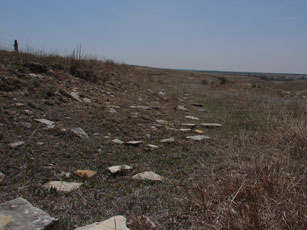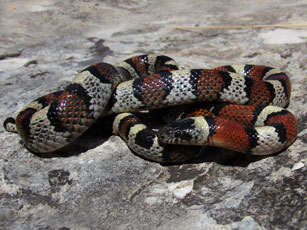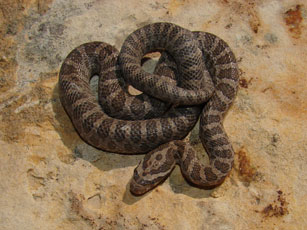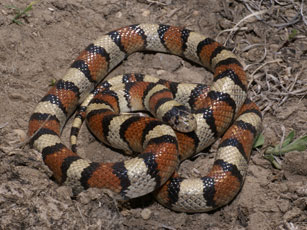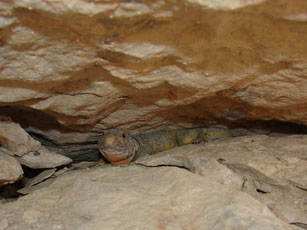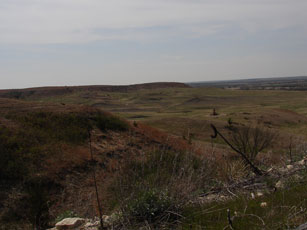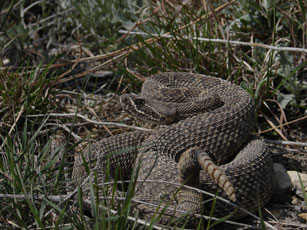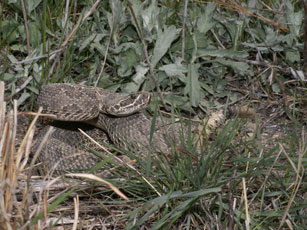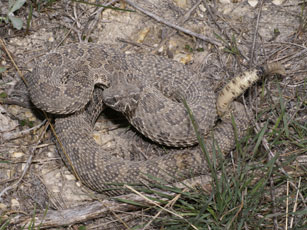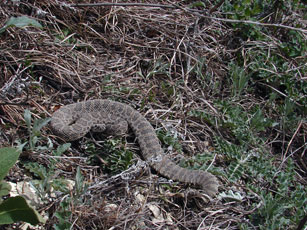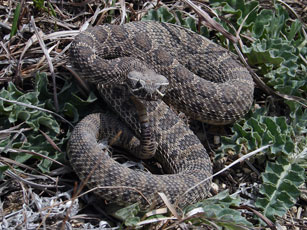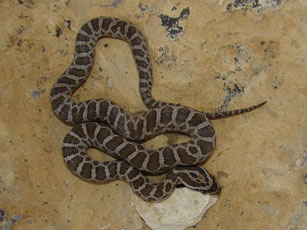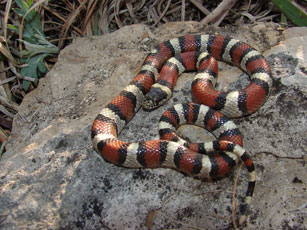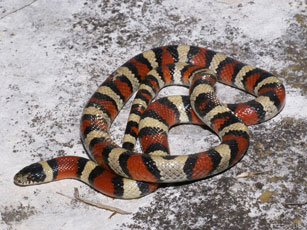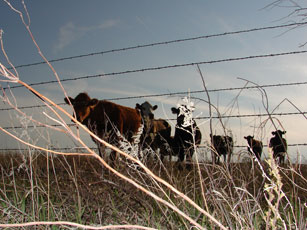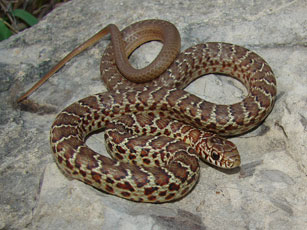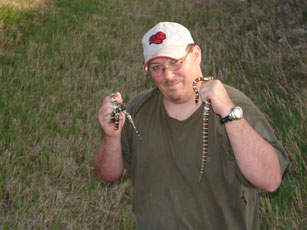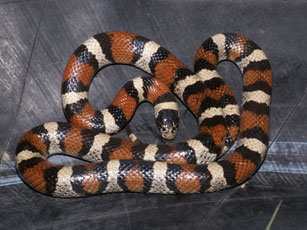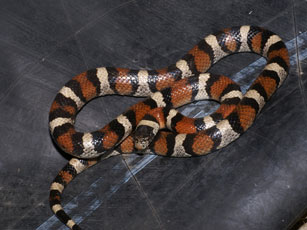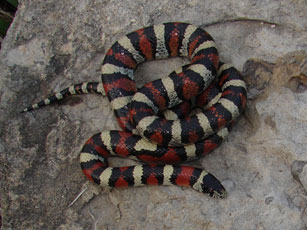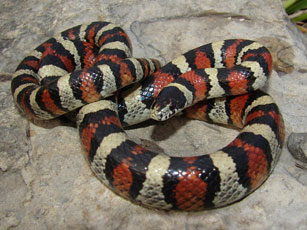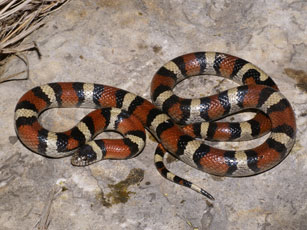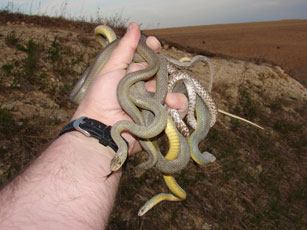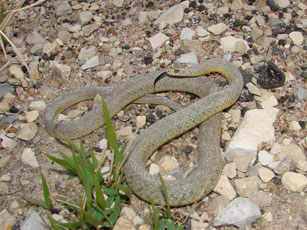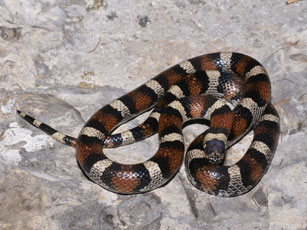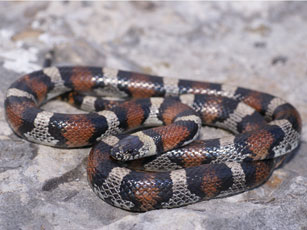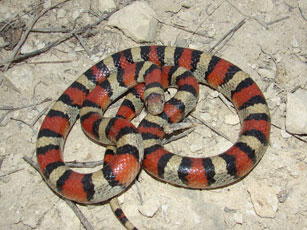
4-28-08
Photo by Matt Ricklefs
Trip Details
Kansas Whirlwind Trip - Day 3
Start Time: 12:45 p.m.
Location: Ellis County, KS
Weather: Cool in the morning. By the start if herping, it was about 66 degrees. Sunny with mild wind.
Herpers: Chad Whitney, Jim Scharosch & Matt Ricklefs
Account by: Matt Ricklefs
Thought of the Day: An awesome day to herp.
As with the other days, it was cool in the morning, but it was sunny and compared to Sunday morning it was glorious. We cooked up a hearty prairie breakfast and headed to meet up with one of Kansas' own herp phenomenon’s Chad Whitney. We weren't able to get together until about Noon. We would only have a few hours to herp with Chad as he had been struggling to write a paper (which he ultimately conquered) but we were eager to get out with him. I had never met Chad so was very glad to finally meet him. I can say that having met him, he is a great guy. We headed for a spot that had produced some milks and we were anxious to check it out. The location was picture perfect. Not long after being there we found our first Central Plains Milk Snake (Lampropeltis t. gentilis).
Photos by Matt Ricklefs
Again, it was similar in size to the other milks we had found, this one being about sixteen inches. Soon after we had another one about twenty-one inches.
Photo by Jim Scharosch
After that Chad found a nice juvenile Great Plains Rat Snake (Elaphe emoryi) about thirteen inches in length.
Photo by Matt Ricklefs
It was steadily getting warmer and was about 1:30 p.m. We had great finds for such a short period. The next find was another "gentilis". This one was the largest so far at twenty-three inches.
Photos by Jim Scharosch
Photo by Matt Ricklefs
These are the first Central Plains Milks I had found and they were awesome. I was to find the next edition to our species list. It was a juvenile Woodhouse's Toad (Bufo woodhousii) about two and a half inches long.
Photo by Matt Ricklefs
Not long after finding the toad, Chad and Jim spotted a nice male Eastern Collard Lizard (Crotaphytus c. collaris).
Photos by Matt Ricklefs
We took some time to get this one and get some pictures. In the process I gained a nice battle scar. It is easy to forget how hard these lizards can clamp down. It is rather impressive. We found another one a short time later. Each of these was about eleven inches long. This area, Chad also told us, was rich in fossils and I did get a nice picture of a fossil nautilus.
Photo by Matt Ricklefs
Alas, it was time for Chad to get back to his paper. Although we all wanted to hang out longer, we had to part ways. We did leave Chad with a couple of parting gifts. A Knubby CD (Jim's band that plays original music) and Serpent's Moon (my CD of original music that Jim is also a part of).
We headed for an area that I was most excited for. It was a den for Prairie Rattlesnakes.
Photo by Matt Ricklefs
I have a lot of experience over a lot of years with Timber Rattlesnakes, but “timbers” are the only Crotalus I have found. I was pumped to find another species. We arrived at the area about 2:00 p.m. Jim took the lead as he had been here before and was already knew the area. I was not quite ready for this habitat. The hills are steep with loose gravelly rock. This is interspersed with bushy outcrops and the rattlers can be anywhere. Jim spotted a double quite quickly. They stayed put for a short time as I wanted to see them in situ. We then went for them, but one was too fast and jolted down the hole they were near. Jim snagged the other. We took it to the flat part of where we were to take pictures. I was awestruck. It was amazing. They are as nasty as I knew they would be. I fair amount different than the so-to-speak docile Timber Rattlesnake. This one was about thirty inches.
Above photos by Matt Ricklefs
Above photos by Jim Scharosch
Not huge, but it was great to me. We took a while to get some good shots and then put it back and looked for others. Again, Jim spotted a double and went for it quickly, but again one was too close to retreat and we got the second. This one was a little smaller at about twenty-six inches.
Photos by Matt Ricklefs
This one was just as nasty, but did not pose as well. It instead relied on the face the enemy and back up rather than the straight out stand your ground method of defense. Again, I stared in wonder. We took another good round of pictures and headed out. We found one other snake that we had found previous, a juvenile Great Plains Rat Snake (Elaphe emoryi) about thirteen inches.
Photo by Matt Ricklefs
That was all for this spot. We had a few other spots to hit, the weather was very nice and we wanted to get as much in as we could before we lost all light and we also needed to get to our next campsite.
The next finds were found over a fair distance apart and in quite rapid succession. We were busting it to get the most out of the last of the day. Rather than bore you with more rambling (too late I know) I will hit the highlights with times.
6:43 p.m.
A double under one rock. Central Plains Milk Snakes (Lampropeltis t. gentilis). One was twenty-one inches the other was about eighteen inches.
Photo by Matt Ricklefs
Photos by Jim Scharosch
We also encountered some cows that came to see what in the heck we were doing.
Photo by Matt Ricklefs
6:57 p.m.
A fourteen inch juvenile Eastern Yellowbelly Racer (Coluber constrictor flaviventris).
Photo by Matt Ricklefs
6:59 p.m.
ANOTHER double under one rock. Central Plains Milk Snakes (Lampropeltis t. gentilis). Both were about eighteen inches. No cows this time around.
Photos by Jim Scharosch
Photos by Matt Ricklefs
7:15 p.m.
Jim found another milk snake, about the same size as the ones we had been finding all day.
Photos by Jim Scharosch
7:43 p.m.
I flipped one rock and found two Eastern Yellowbelly Racers (Coluber constrictor flaviventris) each was just getting past juvenile stage and still retained some of the markings. They were about seventeen inches in length. I had one rock nearby that I decided to turn quick and found two more racers and a juvenile Great Plains Rat Snake (Elaphe emoryi) about thirteen inches long. So in quick succession under two rock I scored 4 racers and the rat snake. I took some individual pictures and a "medusa" shot with all in hand.
Photos by Matt Ricklefs
7:45 p.m.
Jim found another Central Plains Milk Snakes (Lampropeltis t. gentilis) about eighteen inches. This one was particularly dark in color.
Photos by Jim Scharosch
7:55 p.m.
As Jim worked getting pictures of his milk snake I had a few more rocks to look under where I was. As he finished, I told him I just had a one more rock. Based on the amount of racers I had found he said "Flip the rock and get that racer and then we'll call it a day". He was wrong. I instead found the last Central Plains Milk Snake (Lampropeltis t. gentilis) of the day.
Photos by Matt Ricklefs
It was a rather pretty one at that. However, it was late and dark and cooling down. It was time to call it quits. We reported in to Chad what we had found and he confirmed a successful end to the paper he had to write.
Tune in next time as we say goodbye to the hills of Kansas...
...and Happy - well you know by now how this goes.

